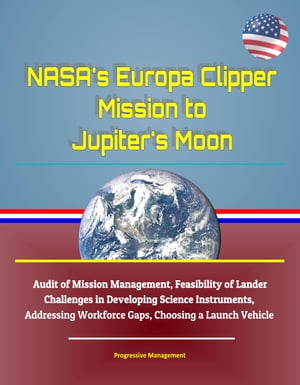to smo bili miニュース!
to smo bili miのコレクター大集合!安心の通販店舗など提供してます
NASA's Europa Clipper Mission to Jupiter's Moon: Audit of Mission Management, Feasibility of Lander, Challenges in Developing Science Instruments, Addressing Workforce Gaps, Choosing a Launch Vehicle【電子書籍】[ Progressive Management ]
NASA's Europa Clipper Mission to Jupiter's Moon: Audit of Mission Management, Feasibility of Lander, Challenges in Developing Science Instruments, Addressing Workforce Gaps, Choosing a Launch Vehicle【電子書籍】[ Progressive Management ]
<p>This excellent report, issued by NASA's Office of Inspector General in May 2019, has been professionally converted for accurate flowing-text e-book format reproduction. Scientists believe that Europa, one of Jupiter's 79 known moons, may have a large liquid ocean below its icy surface suitable to sustain life. The National Research Council (NRC)ーwhich publishes a decadal survey of recommended priorities that NASA uses to help plan its science exploration missionsーdetermined in 2011 that an orbiter mission to Europa should be NASA's second highest priority large-scale planetary science mission after the Mars 2020 mission.</p> <p>Congress has taken a strong interest in the project and since fiscal year (FY) 2013 has appropriated about $2.04 billion to NASA for a Europa missionー$1.26 billion more than the Agency requested. The former Chairman of the House subcommittee that funds the Agency, a long-time advocate for NASA and the Europa mission in particular, was largely responsible for these substantial appropriations. Congress also directed NASA to plan two separate missionsー a flyby orbiter known as Europa Clipper and a Lander mission to place scientific instruments on the moon's surface. In FYs 2017 and 2018, Congress directed NASA to use the Space Launch System (SLS), the Agency's heavy-lift rocket currently under development, as the launch vehicle for both missions and specified launch dates of no later than 2022 for the orbiter and 2024 for the Lander. In February 2019, Congress delayed those launch dates by a year to 2023 and 2025, respectively. NASA's Jet Propulsion Laboratory (JPL) has overall project management responsibilities for both missions.</p> <p>In this audit, we examined NASA's management of the Europa mission relative to achieving technical objectives, meeting milestones, controlling costs, and addressing congressional requirements. To complete this work, we reviewed documents, reports, schedule projections, budget allocations, costs, and risks related to the Clipper and Lander projects, as well as NASA and JPL policies, congressional mandates, and NRC reports. We also compared the Europa mission with other JPL projects and interviewed Clipper and Lander personnel, other NASA officials, and members of the scientific community.</p> <p>This compilation includes a reproduction of the 2019 Worldwide Threat Assessment of the U.S. Intelligence Community.</p> <ol> <li>Introduction * Background * 2. NASA Faces Steep Challenges in Developing Europa Clipper's Science Instruments, Addressing Workforce Gaps, Choosing a Launch Vehicle, and Overcoming Funding Risks * Instrument and Workforce Challenges Pose Cost and Schedule Risks * SLS Unlikely to Be Available for a 2023 Launch * Launch Vehicle Choice and Risks Remain Unresolved * Clipper Joint Cost and Schedule Confidence Level Unreliable for Informing Management Decisions * Sustained Funding Needed to Avoid Clipper Launch Delay or Impact to Other Projects * 3. Congressional Directive to Launch a Europa Lander by 2025 Not Feasible * Workforce and Schedule Risks Render Lander Launch in 2025 Not Feasible * SLS Block 1B Delivery for 2025 Lander Launch Unlikely * Lander Mission Inconsistent with Strategic Priorities Recommended by the NRC * Funding Availability * 4. Conclusion * 5. Recommendations, Management's Response, and Our Evaluation</li> </ol>画面が切り替わりますので、しばらくお待ち下さい。
※ご購入は、楽天kobo商品ページからお願いします。
※切り替わらない場合は、こちら をクリックして下さい。
※このページからは注文できません。
- 商品価格:636円
- レビュー件数:0件
- レビュー平均:0(5点満点)
- ショップ :楽天Kobo電子書籍ストア
© to smo bili miニュース!
